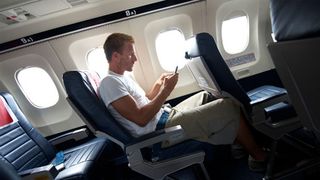Apps and gadgets for your next flight
Don't leave home without these

If you haven't taken a plane trip since the last family holiday a couple of years ago, the next time you travel you'll notice big changes as far as technology is concerned.
Where we once used to hide our smartphones from flight attendants, passengers are increasingly encouraged to use their portable devices at the airport and on board; indeed, technology is impacting air travel in lots of exciting new ways.
Inflight internet
A disappointing announcement of late last year was Qantas tossing its plans for inflight internet service. After trialling the service on flights from the East coast to the US, the airline declared the take-up wasn't sufficient to warrant a full-scale roll out.
Although this is a major step back for inflight connectivity in this country, thankfully other airlines are forging ahead with their internet services.
Etihad, Emirates, Singapore Airlines, United and Garuda are some of the airlines offering Wi-Fi on selected flights in and out of Australia, with prices ranging up to US$25.
Some airlines also allow you to use your mobile phone to make and receive calls, texts and emails — perfect for business travellers who need to stay connected.
Etihad's mobile phone services start from around US$10, with calls charged at the user's international roaming rate.
Get daily insight, inspiration and deals in your inbox
Get the hottest deals available in your inbox plus news, reviews, opinion, analysis and more from the TechRadar team.
Content streaming
Although nixing its plans for internet access on board, Qantas hasn't completely closed the door on new tech in its aircraft.
The airline has begun another trial, this time offering content streaming to passengers on selected domestic flights. The trial involves handing all passengers an Apple iPad 2 and allowing them to access movies, TV programs and music over Wi-Fi.
Qantas plans to eventually allow content to be streamed to passengers' own mobile devices, but currently the service will only work with the provided tablets.
One step ahead, Virgin Australia is trialling a similar service on domestic flights, although this streaming service will work on passengers' iOS devices and on notebooks running Microsoft Silverlight software.
Passengers need to download a free iPhone or iPad app to gain access to over 300 hours of movies, TV and music. All streaming content is free of charge.
Inflight gadgets
Apart from the most obvious electronic equipment that will keep you entertained, connected and productive while in the air (such as notebooks, tablets, smartphones, ereaders and gaming devices), there are a number of other gadgets you should consider taking with you to make your journey more comfortable.
When I'm packing for a flight, the first thing I look for are my noise-cancelling headphones.
Wearing them is like presenting your brain with a cup of warm milk — that droning engine noise and all the distracting background noises become muffled so your head can relax a little.
You can listen to your own music, plug the noise-cancelling headphones into the inflight entertainment for clearer sound, or sit back in silence and have a snooze.
There are plenty of options on the market including the sleek, top-end Bose QuietComfort 3 ($449), as well as the lightweight and compact Sennheiser PXC 250-II ($229).

Some airlines offer power to all passengers on a plane, others save those kind of goodies for travellers in first and business class cabins.
If you aren't lucky enough to have an unlimited power supply for your electronic goodies while in the air, you'll need to bring backup power with you.
We like the elegance of the Powerbag (from US$139.99) for recharging all sorts of devices. Powerbags come in various sizes and styles.
They look like ordinary backpacks, messenger bags and briefcases, but they come equipped with a battery and a variety of connectors, so you can charge up to four devices at a time. Apparently one Powerbag top-up will charge a smartphone at least twice.
Most Popular


